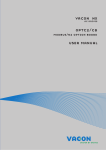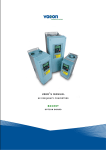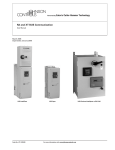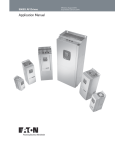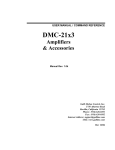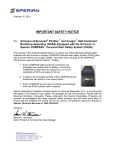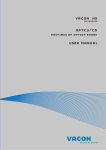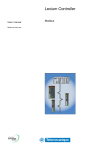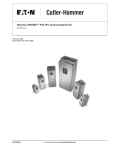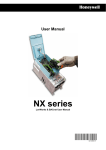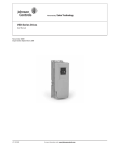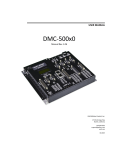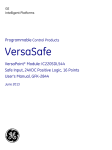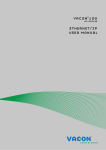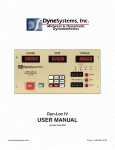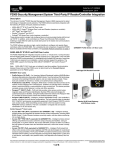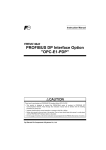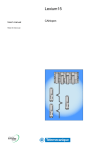Download N2 and MODBUS Communication Kit User Manual
Transcript
Powered by Eaton’s Cutler-Hammer Technology N2 and MODBUS Communication Kit User Manual November 2004 Supersedes August 2004 VS IntelliPass Bypass LIT-1201829 VS Open For more information visit: www.johnsoncontrols.com Powered by Eaton’s Cutler-Hammer Technology N2 and MODBUS Communication Kit User Manual November 2004 Important Notice – Please Read The product discussed in this literature is subject to terms and conditions outlined in Johnson Controls selling policies. The sole source governing the rights and remedies of any purchaser of this equipment is the relevant Johnson Controls selling policy. NO WARRANTIES, EXPRESS OR IMPLIED, INCLUDING WARRANTIES OF FITNESS FOR A PARTICULAR PURPOSE OR MERCHANTABILITY, OR WARRANTIES ARISING FROM COURSE OF DEALING OR USAGE OF TRADE, ARE MADE REGARDING THE INFORMATION, RECOMMENDATIONS AND DESCRIPTIONS CONTAINED HEREIN. In no event will Johnson Controls or Eaton Electrical Inc. be responsible to the purchaser or user in contract, in tort (including negligence), strict liability or otherwise for any special, indirect, incidental or consequential damage or loss whatsoever, including but not limited to damage or loss of use of equipment, plant or power system, cost of capital, loss of power, additional expenses in the use of existing power facilities, or claims against the purchaser or user by its customers resulting from the use of the information, recommendations and descriptions contained herein. The information contained in this manual is subject to change without notice. Cover Photo: Johnson Controls VS Series Drives. LIT-1201829 For more information visit: www.johnsoncontrols.com i N2 and MODBUS Communication Kit User Manual Powered by Eaton’s Cutler-Hammer Technology November 2004 Table of Contents LIST OF FIGURES . . . . . . . . . . . . . . . . . . . . . . . . . . . . . . . . . . . . . . . . . . . . . . . . . . . . . . . LIST OF TABLES . . . . . . . . . . . . . . . . . . . . . . . . . . . . . . . . . . . . . . . . . . . . . . . . . . . . . . . . SAFETY . . . . . . . . . . . . . . . . . . . . . . . . . . . . . . . . . . . . . . . . . . . . . . . . . . . . . . . . . . . . . . . Definitions and Symbols . . . . . . . . . . . . . . . . . . . . . . . . . . . . . . . . . . . . . . . . . . . . . Hazardous High Voltage . . . . . . . . . . . . . . . . . . . . . . . . . . . . . . . . . . . . . . . . . . . . . iii iii iv iv iv CHAPTER 1 — OVERVIEW . . . . . . . . . . . . . . . . . . . . . . . . . . . . . . . . . . . . . . . . . . . . . . . 1-1 Introduction . . . . . . . . . . . . . . . . . . . . . . . . . . . . . . . . . . . . . . . . . . . . . . . . . . . . . . . 1-1 Specifications . . . . . . . . . . . . . . . . . . . . . . . . . . . . . . . . . . . . . . . . . . . . . . . . . . . . . . 1-1 CHAPTER 2 — BOARD LAYOUT AND CONNECTIONS . . . . . . . . . . . . . . . . . . . . . . . . 2-1 OPTC2 Communication Board . . . . . . . . . . . . . . . . . . . . . . . . . . . . . . . . . . . . . . . . 2-1 OPTC8 Communication Board with D-Sub Connector . . . . . . . . . . . . . . . . . . . . . 2-2 CHAPTER 3 — INSTALLATION . . . . . . . . . . . . . . . . . . . . . . . . . . . . . . . . . . . . . . . . . . . . Making the Ground Connection . . . . . . . . . . . . . . . . . . . . . . . . . . . . . . . . . . . . . . . Bus Terminal Resistors . . . . . . . . . . . . . . . . . . . . . . . . . . . . . . . . . . . . . . . . . . . . . . Bus Biasing . . . . . . . . . . . . . . . . . . . . . . . . . . . . . . . . . . . . . . . . . . . . . . . . . . . . . . . . LED Indications. . . . . . . . . . . . . . . . . . . . . . . . . . . . . . . . . . . . . . . . . . . . . . . . . . . . . Installing the C2 Communication Board . . . . . . . . . . . . . . . . . . . . . . . . . . . . . . . . 3-1 3-1 3-3 3-4 3-6 3-7 CHAPTER 4 — COMMISSIONING . . . . . . . . . . . . . . . . . . . . . . . . . . . . . . . . . . . . . . . . . . 4-1 Fieldbus Board Parameters . . . . . . . . . . . . . . . . . . . . . . . . . . . . . . . . . . . . . . . . . . . 4-1 RS-485 Communication Parameters. . . . . . . . . . . . . . . . . . . . . . . . . . . . . . . . . . . . 4-1 CHAPTER 5 — JOHNSON CONTROLS METASYS N2 PROTOCOL . . . . . . . . . . . . . . . 5-1 Overview . . . . . . . . . . . . . . . . . . . . . . . . . . . . . . . . . . . . . . . . . . . . . . . . . . . . . . . . . . 5-1 N2 Point Map . . . . . . . . . . . . . . . . . . . . . . . . . . . . . . . . . . . . . . . . . . . . . . . . . . . . . . 5-3 ii CHAPTER 6 — MODBUS . . . . . . . . . . . . . . . . . . . . . . . . . . . . . . . . . . . . . . . . . . . . . . . . . MODBUS RTU Protocol . . . . . . . . . . . . . . . . . . . . . . . . . . . . . . . . . . . . . . . . . . . . . . Supported Functions . . . . . . . . . . . . . . . . . . . . . . . . . . . . . . . . . . . . . . . . . . . . . . . . Exception Responses . . . . . . . . . . . . . . . . . . . . . . . . . . . . . . . . . . . . . . . . . . . . . . . . MODBUS Interface . . . . . . . . . . . . . . . . . . . . . . . . . . . . . . . . . . . . . . . . . . . . . . . . . . Start-Up Test . . . . . . . . . . . . . . . . . . . . . . . . . . . . . . . . . . . . . . . . . . . . . . . . . . . . . . . 6-1 6-1 6-2 6-4 6-6 6-13 CHAPTER 7 — COMMUNICATION BOARD FAULT TRACKING . . . . . . . . . . . . . . . . . . APPENDIX A — PROCESS DATA . . . . . . . . . . . . . . . . . . . . . . . . . . . . . . . . . . . . . . . . . . Process Data OUT (Slave ➔ Master) . . . . . . . . . . . . . . . . . . . . . . . . . . . . . . . . . . . Process Data IN (Master ➔ Slave) . . . . . . . . . . . . . . . . . . . . . . . . . . . . . . . . . . . . . 7-1 A-1 A-1 A-1 For more information visit: www.johnsoncontrols.com LIT-1201829 Powered by Eaton’s Cutler-Hammer Technology N2 and MODBUS Communication Kit User Manual November 2004 List of Figures Figure 2-1: Option Board OPTC2 Communication Board . . . . . . . . . . . . . . . . . . . . . . . . . Figure 2-2: Option Board OPTC8 Communication Board with D-Sub Connector . . . . . . Figure 3-1: Cable Stripping . . . . . . . . . . . . . . . . . . . . . . . . . . . . . . . . . . . . . . . . . . . . . . . . . . Figure 3-2: Inserting the Data Cables . . . . . . . . . . . . . . . . . . . . . . . . . . . . . . . . . . . . . . . . . Figure 3-3: Grounding the Communication Cable . . . . . . . . . . . . . . . . . . . . . . . . . . . . . . . Figure 3-4: Stripping the Communication Cables . . . . . . . . . . . . . . . . . . . . . . . . . . . . . . . Figure 3-5: Grounding the Communication Cable . . . . . . . . . . . . . . . . . . . . . . . . . . . . . . . Figure 3-6: Using Jumper X4 to Set the Bus Termination . . . . . . . . . . . . . . . . . . . . . . . . . Figure 3-7: Grounding Jumper X1 . . . . . . . . . . . . . . . . . . . . . . . . . . . . . . . . . . . . . . . . . . . . Figure 3-8: Connecting Resistor Biasing . . . . . . . . . . . . . . . . . . . . . . . . . . . . . . . . . . . . . . . Figure 3-9: LED Indications on the Communication Board . . . . . . . . . . . . . . . . . . . . . . . . Figure 4-1: Communication Status . . . . . . . . . . . . . . . . . . . . . . . . . . . . . . . . . . . . . . . . . . . Figure 6-1: The Basic Structure of a Modbus Frame . . . . . . . . . . . . . . . . . . . . . . . . . . . . . 2-1 2-2 3-1 3-1 3-2 3-2 3-3 3-3 3-4 3-5 3-6 4-2 6-1 List of Tables Table 1-1: Specifications . . . . . . . . . . . . . . . . . . . . . . . . . . . . . . . . . . . . . . . . . . . . . . . . . . . . Table 2-1: OPTC2 Bus Connector Signals . . . . . . . . . . . . . . . . . . . . . . . . . . . . . . . . . . . . . . Table 2-2: OPTC8 Bus Connector Signals . . . . . . . . . . . . . . . . . . . . . . . . . . . . . . . . . . . . . . Table 3-1: Bias Resistor Size vs. Number of Nodes. . . . . . . . . . . . . . . . . . . . . . . . . . . . . . . Table 3-2: Communication Board Status LED (BS) — YELLOW . . . . . . . . . . . . . . . . . . . . Table 3-3: Fieldbus Status LED (FS) — GREEN . . . . . . . . . . . . . . . . . . . . . . . . . . . . . . . . . . Table 3-4: Installing the C2 Communication Board . . . . . . . . . . . . . . . . . . . . . . . . . . . . . . Table 4-1: Changing the Modbus Board Commissioning Parameter Values . . . . . . . . . . Table 4-2: Communication Message Indications . . . . . . . . . . . . . . . . . . . . . . . . . . . . . . . . Table 5-1: Analog Inputs (AI) . . . . . . . . . . . . . . . . . . . . . . . . . . . . . . . . . . . . . . . . . . . . . . . . Table 5-2: Binary Inputs (BI) . . . . . . . . . . . . . . . . . . . . . . . . . . . . . . . . . . . . . . . . . . . . . . . . . Table 5-3: Analog Outputs (AO) . . . . . . . . . . . . . . . . . . . . . . . . . . . . . . . . . . . . . . . . . . . . . . Table 5-4: Binary Outputs (BO) . . . . . . . . . . . . . . . . . . . . . . . . . . . . . . . . . . . . . . . . . . . . . . . Table 5-5: Internal Integers (ADI) . . . . . . . . . . . . . . . . . . . . . . . . . . . . . . . . . . . . . . . . . . . . . Table 6-1: Supported Messages . . . . . . . . . . . . . . . . . . . . . . . . . . . . . . . . . . . . . . . . . . . . . . Table 6-2: Exception Response Codes . . . . . . . . . . . . . . . . . . . . . . . . . . . . . . . . . . . . . . . . . Table 6-3: Index Table . . . . . . . . . . . . . . . . . . . . . . . . . . . . . . . . . . . . . . . . . . . . . . . . . . . . . . Table 6-4: Process Data Slave ➔ Master — (max. 22 bytes) . . . . . . . . . . . . . . . . . . . . . . . Table 6-5: Process Data Master ➔ Slave — (max. 22 bytes) . . . . . . . . . . . . . . . . . . . . . . . Table 6-6: Fieldbus Basic Input Table . . . . . . . . . . . . . . . . . . . . . . . . . . . . . . . . . . . . . . . . . . Table 6-7: Control Word Bit Descriptions . . . . . . . . . . . . . . . . . . . . . . . . . . . . . . . . . . . . . . Table 6-8: Fieldbus Basic Output Table . . . . . . . . . . . . . . . . . . . . . . . . . . . . . . . . . . . . . . . . Table 6-9: Status Word Bit Descriptions . . . . . . . . . . . . . . . . . . . . . . . . . . . . . . . . . . . . . . . Table 6-10: Parameters . . . . . . . . . . . . . . . . . . . . . . . . . . . . . . . . . . . . . . . . . . . . . . . . . . . . . Table 6-11: Actual Values . . . . . . . . . . . . . . . . . . . . . . . . . . . . . . . . . . . . . . . . . . . . . . . . . . . Table 7-1: Communication Board Faults . . . . . . . . . . . . . . . . . . . . . . . . . . . . . . . . . . . . . . . Table 7-2: AFD Response to Faults . . . . . . . . . . . . . . . . . . . . . . . . . . . . . . . . . . . . . . . . . . . Table A-1: Process Data OUT . . . . . . . . . . . . . . . . . . . . . . . . . . . . . . . . . . . . . . . . . . . . . . . . Table A-2: Process Data IN — VS Series Applications . . . . . . . . . . . . . . . . . . . . . . . . . . . . LIT-1201829 For more information visit: www.johnsoncontrols.com 1-1 2-1 2-2 3-4 3-6 3-6 3-7 4-1 4-2 5-3 5-4 5-4 5-5 5-5 6-2 6-4 6-6 6-6 6-7 6-7 6-8 6-9 6-9 6-10 6-10 7-1 7-1 A-1 A-1 iii N2 and MODBUS Communication Kit User Manual Powered by Eaton’s Cutler-Hammer Technology November 2004 Safety Definitions and Symbols WARNING This symbol indicates high voltage. It calls your attention to items or operations that could be dangerous to you and other persons operating this equipment. Read the message and follow the instructions carefully. This symbol is the “Safety Alert Symbol.” It occurs with either of two signal words: CAUTION or WARNING, as described below. WARNING Indicates a potentially hazardous situation which, if not avoided, can result in serious injury or death. CAUTION Indicates a potentially hazardous situation which, if not avoided, can result in minor to moderate injury, or serious damage to the product. The situation described in the CAUTION may, if not avoided, lead to serious results. Important safety measures are described in CAUTION (as well as WARNING). Hazardous High Voltage WARNING Motor control equipment and electronic controllers are connected to hazardous line voltages. When servicing drives and electronic controllers, there may be exposed components with housings or protrusions at or above line potential. Extreme care should be taken to protect against shock. Stand on an insulating pad and make it a habit to use only one hand when checking components. Always work with another person in case an emergency occurs. Disconnect power before checking controllers or performing maintenance. Be sure equipment is properly grounded. Wear safety glasses whenever working on electronic controllers or rotating machinery. iv For more information visit: www.johnsoncontrols.com LIT-1201829 Powered by Eaton’s Cutler-Hammer Technology N2 and MODBUS Communication Kit User Manual November 2004 Chapter 1 — Overview Introduction The Johnson Controls VS Series Drives powered by Cutler-Hammer® technology from Eaton’s electrical business can be controlled, monitored and programmed from a host system via Johnson Controls N2 or MODBUS RTU communication protocols with the addition of the OPTC2 RS-485 Communication Option Board kit. If you purchase your Communication Board Kit separate from the drive, please note that it must be installed in slot E on the control board of the VS Series drive. Specifications Table 1-1: Specifications Item Specification Communication Board Connections Interface OPTC2: Pluggable connector (5.08 mm) OPTC8: 9-pin DSUB connector (female) Data Transfer Method RS-485, half-duplex Transfer Cable Twisted pair (1 pair and shield) Electrical Isolation 500V DC Communications Johnson Controls N2 As described in Metasys N2 System Protocol Specification Modbus RTU As described in “Modicon Modbus Protocol Reference Guide” found at: http://public.modicon.com/ Baud Rate 300, 600, 1200, 2400, 4800, 9600, 19200 and 38400 Kbaud Addresses 1 to 247 Environment Ambient Operating Temperature 14 to 131°F (-10 to 55°C) Storage Temperature -40 to 140°F (-40 to 60°C) Humidity <95%, non-condensing Altitude Max. 3280 ft. (1000m) Vibration 0.5G at 9 to 200 Hz Safety LIT-1201829 Standards Fulfils EN 50178 standard Certification CE, UL For more information visit: www.johnsoncontrols.com 1-1 N2 and MODBUS Communication Kit User Manual Powered by Eaton’s Cutler-Hammer Technology November 2004 1-2 For more information visit: www.johnsoncontrols.com LIT-1201829 Powered by Eaton’s Cutler-Hammer Technology N2 and MODBUS Communication Kit User Manual November 2004 Chapter 2 — Board Layout and Connections The RS-485 Communication Board is connected to the communications bus through either a 5-pin pluggable bus connector (board OPTC2) or a 9-pin female D-sub connector (board OPTC8). Communication with the control board of the drive takes place through the standard Interface Board Connector (see Figures 2-1 and 2-2). OPTC2 Communication Board Yellow = RS-485 Board Status Green = Field Bus Status 1 2 3 4 5 X4 X1 Bus Connector Jumpers Interface Board Connector Figure 2-1: Option Board OPTC2 Communication Board Table 2-1: OPTC2 Bus Connector Signals Signal Connector Description NC 1 No connection VP 2 Supply voltage – plus (5V) RxD/TxD –N 3 Receive/Transmit data – minus (A) RxD/TxD –P 4 Receive/Transmit data – plus (B) DGND 5 Data ground (reference potential for VP) This pin (1) can be used to bypass the cable shield to the next slave. X4 jumper is the 120Ω termination resistor. Set X4 jumper to ON only if the Johnson Controls drive is the last device on the network. ON X1 jumper has no effect on OPTC2 board. It is used on the OPTC8 board on the following page. OFF LIT-1201829 For more information visit: www.johnsoncontrols.com 2-1 N2 and MODBUS Communication Kit User Manual Powered by Eaton’s Cutler-Hammer Technology November 2004 OPTC8 Communication Board with D-Sub Connector 5 4 9 3 8 2 7 1 6 X4 X1 Bus Connector Jumpers Interface Board Connector Figure 2-2: Option Board OPTC8 Communication Board with D-Sub Connector Table 2-2: OPTC8 Bus Connector Signals Signal Connector Description Shield 1 Cable shield RxD/TxD –N 3 Receive/Transmit data – minus (A) DGND 5 Data ground (reference potential for VP) VP 6 Supply voltage – (+5V) RxD/TxD –P 8 Receive/Transmit data – plus (B) X4 jumper is the 120Ω termination resistor. Set X4 jumper to ON only if the Johnson Controls drive is the last device on the network. ON OFF 2-2 X1 jumper is used for grounding selection on the OPTC8 board only. ON position means that D-sub connector PIN 1 is connected directly to ground. OFF position means that PIN 1 is connected via RC filter to ground. For more information visit: www.johnsoncontrols.com LIT-1201829 Powered by Eaton’s Cutler-Hammer Technology N2 and MODBUS Communication Kit User Manual November 2004 Chapter 3 — Installation Making the Ground Connection Grounding by Clamping the Cable to the Converter Frame This method of grounding is the most effective, and especially recommended when the distances between the devices are relatively short or if the device is the last device on the network. Note: Normally, the option board has already been installed in slot E of the control board. It is not necessary to detach the whole board to ground the bus cable shield. Just detach the terminal block. 1. Strip about 2 in. (5 cm) of the communication cable and cut off the gray cable shield. Remember to do this for both bus cables (except for the last device). See Figure 3-1. 2. Leave no more than 1/4 in. (1 cm) of the cable outside the terminal block and strip the data cables at about 0.2 in (0.5 cm) to fit in the terminals. See Figure 3-1. Note: Do this for both bus cables. Figure 3-1: Cable Stripping 3. Insert the data cables into terminals #3 (Line A) and #4 (Line B). 1 2 3 4 5 A B Figure 3-2: Inserting the Data Cables LIT-1201829 For more information visit: www.johnsoncontrols.com 3-1 N2 and MODBUS Communication Kit User Manual Powered by Eaton’s Cutler-Hammer Technology November 2004 4. Strip the communication cable so that it can be secured to the drive frame with the grounding clamp. Figure 3-3: Grounding the Communication Cable Grounding Only One Point on the Net In this method of grounding, the shield is connected to ground only at the last device on the network. Other devices on the network just bypass the shield. We recommend you to use an Abico connector to fit the shields into the terminal. 1. Strip about 2 in. (5 cm) of the communication cable and cut off the gray cable shield. Remember to do this for both bus cables (except for the last device). 2. Leave no more than 1/4 in. (1 cm) of the cable outside the terminal block and strip the data cables at about 0.5 cm to fit in the terminals. See Figure 3-4. Note: Do this for both bus cables. 1 2 3 4 5 Shield A B Figure 3-4: Stripping the Communication Cables 3-2 For more information visit: www.johnsoncontrols.com LIT-1201829 Powered by Eaton’s Cutler-Hammer Technology N2 and MODBUS Communication Kit User Manual November 2004 3. Secure the communication cable to the drive frame with the grounding clamp as shown in Figure 3-5. Figure 3-5: Grounding the Communication Cable Bus Terminal Resistors If the C2 or C8 Option Card is the last device on the network, the bus termination must be set to ON. Use jumper X4 (set to the ON position for termination). See Figure 3-6. ON = Terminated: This is the last device on network. OFF = Not Terminated: At least one other network device is connected past this device. 1 2 3 4 5 X4 X1 Bus Connector Jumpers Interface Board Connector Figure 3-6: Using Jumper X4 to Set the Bus Termination LIT-1201829 For more information visit: www.johnsoncontrols.com 3-3 N2 and MODBUS Communication Kit User Manual Powered by Eaton’s Cutler-Hammer Technology November 2004 Grounding Jumper X1 The grounding jumper X1 on the OPTC8 is used for grounding selection. If position ON is selected it means that the D-sub connector PIN1 is connected directly to ground. Selection of position OFF means that PIN1 is connected to ground via an RC-filter. Jumper X1 has no effect on OPTC2. See Figure 3-7. 5 4 9 3 8 2 7 1 6 ON OFF X4 X1 Jumpers Figure 3-7: Grounding Jumper X1 Bus Biasing Bus biasing is required to ensure faultless communication between devices at RS-485 bus. Bus biasing makes sure that the bus state has proper potential when no one is transmitting. Without biasing faulty messages can be detected when the bus is in idle state. RS-485 bus state should be from +0.200 to +7V or -0.200 to -7V. Illegal bus state is from -0.200 to 0.200V. Table 3-1: Bias Resistor Size vs. Number of Nodes 3-4 Number of Nodes Bias Resistance 2–5 5 – 10 11 – 20 21 – 30 31 – 40 1.8k ohm 2.7k ohm 12k ohm 18k ohm 27k ohm For more information visit: www.johnsoncontrols.com LIT-1201829 Powered by Eaton’s Cutler-Hammer Technology N2 and MODBUS Communication Kit User Manual November 2004 Failsafe Biasing in OPTC2 Option Board Connect resistor biasing resistors between PIN 2 – PIN 4 and PIN 3 – PIN 5. See Figure 3-8. DataData+ Figure 3-8: Connecting Resistor Biasing National Semiconductor (www.national.com) has a very good application note concerning this problem. It is Failsafe Biasing of Differential Buses (AN-847.PDF). LIT-1201829 For more information visit: www.johnsoncontrols.com 3-5 N2 and MODBUS Communication Kit User Manual Powered by Eaton’s Cutler-Hammer Technology November 2004 LED Indications The two LED indicators next to the connector show the present status of the Communication Board (yellow) and the Fieldbus Module (green). Yellow = RS-485 Board Status Green = Fieldbus Status Yellow Green 1 2 3 4 5 X4 X1 Figure 3-9: LED Indications on the Communication Board Table 3-2: Communication Board Status LED (BS) — YELLOW LED is: Meaning: OFF Option board not activated ON Option board in initialization state waiting for activation command from the Adjustable Frequency Drive (AFD) Blinking fast (once/sec) Option board is activated and in RUN state Option board is ready for external communication Blinking slow (once/5 secs) Option board is activated and in FAULT state Internal fault of option board Table 3-3: Fieldbus Status LED (FS) — GREEN 3-6 LED is: Meaning: OFF Fieldbus module is waiting for parameters from the AFD No external communication ON Fieldbus module is activated Parameters received and module activated Module is waiting for messages from the bus Blinking fast (once/sec) Module is activated and receiving messages from the bus Blinking slow (once/5 secs) Module is in FAULT state No messages from Master within the watchdog time Bus broken, cable loose or Master off-line For more information visit: www.johnsoncontrols.com LIT-1201829 Powered by Eaton’s Cutler-Hammer Technology N2 and MODBUS Communication Kit User Manual November 2004 Installing the C2 Communication Board Table 3-4: Installing the C2 Communication Board Procedure Illustration 1. Remove the cable cover. 2. Open the cover of the control unit. 3. Install the C2 option board in slot E on the control board of the AFD. Make sure that the grounding plate (see below) fits tightly in the clamp. 1 2 3 4 5 X4 X1 Grounding Plate LIT-1201829 For more information visit: www.johnsoncontrols.com 3-7 N2 and MODBUS Communication Kit User Manual Powered by Eaton’s Cutler-Hammer Technology November 2004 Table 3-4: Installing the C2 Communication Board, continued Procedure Illustration 4. Make a sufficiently wide opening for your cable by cutting the cover grid as wide as necessary. 5. Close the cover of the control unit and the cable cover. 3-8 For more information visit: www.johnsoncontrols.com LIT-1201829 Powered by Eaton’s Cutler-Hammer Technology N2 and MODBUS Communication Kit User Manual November 2004 Chapter 4 — Commissioning Fieldbus Board Parameters The RS-485 Communication boards (OPTC2 and OPTC8) are commissioned with the control keypad by giving values to appropriate parameters in the Expander board menu M6. Expander Board Menu (M5) The Expander board menu makes it possible for the user, (1) to see what expander boards are connected to the control board and (2) to view and edit the parameters associated with the expander board. Enter the following menu level (G#) with the menu button Right. At this level, you can browse through slots A to E with the Browser buttons to see which expander boards are installed. On the bottom line of the display, you also see the number of parameter groups associated with the board. If you still press the menu button Right once you will reach the parameter group level where there are two groups: Editable parameters and Monitored values. A further press on the menu button Right takes you to either of these groups. RS-485 Communication Parameters To commission the RS-485 communication board, enter the level P6.4.1.1 from the Parameters group (G6.4.1). Table 4-1: Changing the Modbus Board Commissioning Parameter Values # Name Default Range Description 1 Communication Protocol 2 1 – Modbus RTU 2 – N2 2 Slave Address 1 1…247 3 BAUD Rate 6 1 – 300 baud 2 – 600 baud 3 – 1200 baud 4 – 2400 baud 5 – 4800 baud 6 – 9600 baud 7 – 19200 baud 8 – 38400 baud Communication speed Note: When the N2 protocol is used, the Baud Rate Setting must be: 6 – 9600 baud 4 Parity Type 0 0 – None 1 – Even 2 – Odd Describes what kind of parity checking is used. 5 Communication Timeout 10 0 – OFF 1 – 300 s See Communication Timeout on Page 4-2 6 Operate Mode 1 1 – Normal Reserved for later use The parameters of every device must be set before connecting to the bus. Especially the parameters “SLAVE ADDRESS” and “BAUD RATE” must be the same as in the master configuration. LIT-1201829 For more information visit: www.johnsoncontrols.com 4-1 N2 and MODBUS Communication Kit User Manual Powered by Eaton’s Cutler-Hammer Technology November 2004 Communication Timeout The RS-485 communication board initiates a communication error if communication is broken for as long as defined by Communication Timeout. Communication Timeout is disabled when given the value 0. Communication Status To see the present status of the communication board, enter the Communication status page from the Monitor menu (G6.4.2). See Figure 4-1 and Table 4-2. Monitor Comm. status V1 V1 0.841 Good Message Error Message Figure 4-1: Communication Status Table 4-2: Communication Message Indications Messages Indications Good messages 0 – 999 Number of messages received without communication errors Error messages 0 – 64 4-2 Number of messages received with CRC or parity errors For more information visit: www.johnsoncontrols.com LIT-1201829 Powered by Eaton’s Cutler-Hammer Technology N2 and MODBUS Communication Kit User Manual November 2004 Chapter 5 — Johnson Controls Metasys N2 Protocol Overview The N2 Interface provides: ● Direct control of Drive (e.g. Run, Stop, Direction, Speed reference, Fault reset) ● Full access to necessary parameters ● Monitoring of Drive status (e.g. Output frequency, Output current, Fault code) ● In stand-alone operation, or if the polling is stopped, the overridden values are released after a specified period (about 10 minutes). Analog Input (AI) Features All Analog Input (AI) points have the following features: ● Support Change of State (COS) reporting based on high and low warning limits. ● Support Change of State (COS) reporting based on high and low alarm limits. ● Support Change of State (COS) reporting based on override status. ● Always considered reliable and never out of range. ● Writing of alarm and warning limit values beyond the range that can be held by the drive’s internal variable will result in having that limit replaced by the “Invalid Float” value even though the message is acknowledged. The net result will be the inactivation of the alarm or warning (the same as if the original out of range value was used). ● Overriding is supported from the standpoint that the “Override Active” bit will be set and the value reported to the N2 network will be the overridden value. However, the value in the drive remains unchanged. Therefore, the N2 system should be set up to disallow overriding AI points or have an alarm condition activated when a AI point is overridden. ● Overriding an AI point with a value beyond the limit allowed by the drive’s internal variable will result in an “Invalid Data” error response and the override status and value will remain unchanged. Binary Input (BI) Features All Binary Input (BI) points have the following features: ● Support Change of State (COS) reporting based on current state. ● Support Change of State (COS) reporting based on alarm condition. ● Support Change of State (COS) reporting based on override status. ● Always considered reliable. Overriding is supported from the standpoint that the “Override Active” bit will be set and the value reported to the N2 network will be the overridden value. However, the value in the drive remains unchanged. Therefore, the N2 system should be set up to disallow overriding BI points or have an alarm condition activated when a BI point is overridden. LIT-1201829 For more information visit: www.johnsoncontrols.com 5-1 N2 and MODBUS Communication Kit User Manual Powered by Eaton’s Cutler-Hammer Technology November 2004 Analog Output (AO) Features All Analog Output (AO) points have the following features: ● Support Change of State (COS) reporting based on override status. ● Always considered reliable. ● Overriding of the AO points is the method used to change a value. Overriding an AO point with a value beyond the limit allowed by the drive’s internal variable will result in an “Invalid Data” error response and the override status and value will remain unchanged. If the overridden value is beyond the drive’s parameter limit but within the range that will fit in the variable, an acknowledge response is given and the value will be internally clamped to its limit. ● An AO point override copies the override value to the corresponding drive parameter. This is the same as changing the value on the keypad. The value is nonvolatile and will remain in effect when the drive is turned off and back on. It also remains at this value when the N2 network “Releases” the point. The N2 system always reads the current parameter value. Note: On some N2 systems, the system will not poll the AO point when it is being overridden. In this case, the N2 system will not notice a change in value if the change is made via the keypad. To avoid this scenario, set the point up as a “local control” type and release it once it has been overridden. In this way, the N2 system will monitor the value when not being overridden. Binary Output (BO) Features All Binary Output (BO) points have the following features: ● Support Change of State (COS) reporting based on override status. ● Always considered reliable. ● Overriding BO points control the drive. These points are inputs commands to the drive. When released, the drive’s internal value remains at its last overridden value. Internal Integer (ADI) Features All Internal Integer (ADI) points have the following features: 5-2 ● Do not support Change of State (COS) reporting. ● Can be overridden and the “Override Active” bit will be set. However, the Internal value is unchanged (Read Only). For more information visit: www.johnsoncontrols.com LIT-1201829 Powered by Eaton’s Cutler-Hammer Technology N2 and MODBUS Communication Kit User Manual November 2004 N2 Point Map Analog Input (AI) Point Map Table 5-1: Analog Inputs (AI) NPT NPA Description Units Note AI 1 Speed Setpoint Hz 2 decimals AI 2 Output Speed Hz 2 decimals AI 3 Motor Speed Rpm 0 decimal AI 4 Load (power) % 1 decimal AI 5 Megawatt Hours MWh Total Counter AI 6 Motor Current A 2 decimal AI 7 Bus Voltage V 0 decimal AI 8 Motor Volts V 1 decimal AI 9 Heatsink Temperature °C 0 decimal AI 10 Motor Torque % 1 decimal AI 11 Operating Days Day 0 decimal AI 12 Operating Hours Hour 0 decimal AI 13 Kilowatt Hours kWh Trip Counter AI 14 Torque Reference % 1 decimal AI 15 Motor Temperature Rise AI 1 decimal FBProcessDataOUT1 — 0 decimal AI 17 FBProcessDataOUT2 — 0 decimal AI 18 FBProcessDataOUT3 — 0 decimal 19 FBProcessDataOUT4 — 0 decimal FBProcessDataOUT5 — 0 decimal AI AI 20 AI 21 FBProcessDataOUT6 — 0 decimal AI 22 FBProcessDataOUT7 — 0 decimal 23 — 0 decimal AI LIT-1201829 16 % FBProcessDataOUT8 These analog inputs are application specific. See Table A-1 on Page A-1. For more information visit: www.johnsoncontrols.com 5-3 N2 and MODBUS Communication Kit User Manual Powered by Eaton’s Cutler-Hammer Technology November 2004 Binary Input (BI) Point Map Table 5-2: Binary Inputs (BI) NPT NPA Description 0= 1= BI 1 Ready Not Ready Ready BI 2 Run Stop Run BI 3 Direction Clockwise Counterclockwise BI 4 Faulted Not Faulted Faulted BI 5 Warning Not Warning Warning BI 6 Ref. Frequency reached False True BI 7 Motor running at zero speed False True BI 8 Digital Input Interlock False True BI 9 Bypass Mode Active False True BI 10 Digital Input Fire Mode False True BI 11 Hand Control Mode False True BI 12 Auto Control Mode False True BI 13 Control Mode OFF False True Analog Output (AO) Point Map Table 5-3: Analog Outputs (AO) NPT NPA Description Units Note AO 1 Comms Speed % 2 decimal AO 2 Current Limit A 2 decimal AO 3 Minimum Speed Hz 2 decimal AO 4 Maximum Speed Hz 2 decimal AO 5 Accel Time s 1 decimal AO 6 Decel Time s 1 decimal % 2 decimal % 2 decimal AO AO 5-4 7 8 FB PI Setpoint FB Actual Value These analog outputs are sent to the drive and require Parameter 1.1.15 St Pt source auto to be set to “Fieldbus” for AO-7 and Parameter 1.1.17 PI-Input source to be set to “Fieldbus” for AO-8. For more information visit: www.johnsoncontrols.com LIT-1201829 Powered by Eaton’s Cutler-Hammer Technology N2 and MODBUS Communication Kit User Manual November 2004 Binary Output (BO) Point Map Table 5-4: Binary Outputs (BO) NPT NPA Description 0= 1= BO 1 Comms Start/Stop Stop Start BO 2 Comms Forward/Reverse Forward Reverse BO 3 Comms Reset Fault N/A Reset BO 4 Enable Bypass FB FixedControlWord Bit_3 Disable Enable BO 5 Activate FB.DI-3 FBFixedControlWord Bit_4 OFF ON BO 6 Activate FB.DI-4 FBFixedControlWord Bit_5 OFF ON BO 7 Activate FB.DI-5 FBFixedControlWord Bit_6 OFF ON BO 8 Activate FB.DI-6 FBFixedControlWord Bit_7 OFF ON BO 11 Pass Through RO-1 OFF ON BO 12 Pass Through RO-2 OFF ON BO 13 Pass Through DO-1 OFF ON BO 14 Activate Fire Mode OFF ON BO 15 Comms PM Setback OFF ON These binary outputs are application specific. These can be used to override DI-2 through DI-6 to the “ON” or “Activated” position. Pass Through Digital and Relay Outputs If controlling digital or relay outputs through the fieldbus, set parameters P1.3.6 – P1.3.8 “Not Used” (#0). Internal Integer (ADI) Point Mapping Table 5-5: Internal Integers (ADI) LIT-1201829 NPT NPA ADI 1 Description Units Active Fault Code — For more information visit: www.johnsoncontrols.com 5-5 N2 and MODBUS Communication Kit User Manual Powered by Eaton’s Cutler-Hammer Technology November 2004 5-6 For more information visit: www.johnsoncontrols.com LIT-1201829 Powered by Eaton’s Cutler-Hammer Technology N2 and MODBUS Communication Kit User Manual November 2004 Chapter 6 — Modbus MODBUS RTU Protocol The MODBUS protocol is an industrial communications and distributed control system to integrate PLCs, computers, terminals, and other monitoring, sensing and control devices. MODBUS is a Master-Slave communications protocol. The Master controls all serial activity by selectively polling one or more slave devices. The protocol provides for one master device and up to 247 slave devices on a common line. Each device is assigned an address to distinguish it from all other connected devices. The MODBUS protocol uses the master-slave technique, in which only one device (the master) can initiate a transaction. The other devices (the slaves) respond by supplying the requested data to the master, or by taking the action requested in the query. The master can address individual slaves or initiate a broadcast message to all slaves. Slaves return a message (“response”) to queries that are addressed to them individually. Responses are not returned to broadcast queries from the master. A transaction comprises a single query and single response frame or a single broadcast frame. The transaction frames are defined below. Master’s Message Slave’s Response Start Address Function Data Start Address Function Data CRC End CRC End Figure 6-1: The Basic Structure of a Modbus Frame Valid slave device addresses are in the range of 0 – 247 decimal. The individual slave devices are assigned addresses in the range of 1 – 247. A master addresses a slave by placing the slave address in the address field of the message. When the slave sends its response, it places its own address in this address field of the response to let the master know which slave is responding. The function code field of a message frame contains two characters (ASCII) or eight bits (RTU). Valid codes are in the range of 1 – 255 decimal. When a message is sent from a master to a slave device, the function code field tells the slave what kind of action to perform. Examples are to read the ON/OFF states of a group of discrete coils or inputs; to read the data contents of a group of registers; to read the diagnostic status of the slave; to write to designated coils or registers; or to allow loading, recording or verifying the program within the slave. LIT-1201829 For more information visit: www.johnsoncontrols.com 6-1 N2 and MODBUS Communication Kit User Manual Powered by Eaton’s Cutler-Hammer Technology November 2004 When the slave responds to the master, it uses the function code field to indicate either a normal (error-free) response or that some kind of error occurred (called an exception response). For a normal response, the slave simply echoes the original function code. For an exception response, the slave returns a code that is equivalent to the original function code with its most significant bit set to a logic state of 1. The data field is constructed using sets of two hexadecimal digits, in the range of 00 to FF hexadecimal. These can be made from a pair of ASCII characters, or from one RTU character, according to the network’s serial transmission mode. The data field of messages sent from a master to slave devices contains additional information that the slave must use to take the action defined by the function code. This can include items like discrete and register addresses, the quantity of items to be handled, and the count of actual data bytes in the field. If no error occurs, the data field of a response from a slave to a master contains the data requested. If an error occurs, the field contains an exception code that the master application can use to determine the next action to be taken. Two kinds of checksum are used for standard Modbus networks. The error checking field contents depend upon the transmission method that is being used. Supported Functions Table 6-1: Supported Messages Function Code Description Address Range 03 Read Holding Registers Applies to all addresses 20/20 20/20 04 Read Input Registers Applies to all addresses 06 Write Single Register Applies to all addresses 16 Write Multiple Registers Applies to all addresses Maximum Read/Write 20/20 20/20 Parameters can read or write only once within query. Note: Broadcasting can be used with codes 06 and 16. Read Holding Registers The query message specifies the starting register and the quantity of registers to be read. Registers are addressed starting with zero: registers 1 – 16 are addressed as 0 – 15. Example of a request to read registers 42001 – 42003 from Slave device 1: ADDRESS 01 hex Slave address 01 hex (= 1) FUNCTION 03 hex Function 03 hex (= 3) DATA Starting address HI 07 hex Starting address 07d0 hex (= 2000) Starting address LO D0 hex No. of points HI 00 hex Number of registers 0003 hex (= 3) No. of points LO 03 hex ERROR CHECK CRC HI 05 hex CRC field 0546 hex (= 1350) CRC LO 46 hex 6-2 For more information visit: www.johnsoncontrols.com LIT-1201829 Powered by Eaton’s Cutler-Hammer Technology N2 and MODBUS Communication Kit User Manual November 2004 Read Input Registers The query message specifies the starting register and the quantity of registers to be read. Registers are addressed starting with zero: registers 1 – 16 are addressed as 0 – 15. Example of a request to read registers 32001 from Slave device 1: ADDRESS 01 hex Slave address 01 hex (= 1) FUNCTION 04 hex Function 04 hex (= 4) DATA Starting address HI 07 hex Starting address 07d0 hex (= 2000) Starting address LO D0 hex No. of points HI 00 hex Number of registers 0001 hex (= 1) No. of points LO 01 hex ERROR CHECK CRC HI 31 hex CRC field 3147 hex (= 1350) CRC LO 47 hex Preset Single Register The query message specifies the register reference to be preset. Registers are addressed starting with zero: Register 1 is addressed as 0. Example of a request to preset register 42101 to 00001 hex in Slave device 1: ADDRESS 01 hex Slave address 01 hex (= 1) FUNCTION 06 hex Function 06 hex (= 6) DATA Starting address HI 07 hex Starting address 07d0 hex (= 2000) Starting address LO D0 hex No. of points HI 00 hex Number of registers 0001 hex (= 3) No. of points LO 01 hex Data HI 00 hex Data = 0001 hex (= 1) Data LO 01 hex ERROR CHECK CRC HI B7 hex CRC field B7A2 hex (= 47010) CRC LO A2 hex LIT-1201829 For more information visit: www.johnsoncontrols.com 6-3 N2 and MODBUS Communication Kit User Manual Powered by Eaton’s Cutler-Hammer Technology November 2004 Preset Multiple Registers The query message specifies the register references to be preset. Registers are addressed starting with zero: register 1 is addressed as 0. Example of a request to preset two registers starting at 42001 to 0001 hex and 0010 hex in Slave device 1: ADDRESS 01 hex Slave address 01 hex (= 1) FUNCTION 10 hex Function 10 hex (= 16) DATA Starting address HI 07 hex Starting address 07d0 hex (= 2000) Starting address LO D0 hex No. of registers HI 00 hex Number of registers 0002 hex (= 2) No. of registers LO 02 hex Byte Count 04 hex Byte count 04 hex (= 4) Data HI 00 hex Data 1 = 0001 hex (= 1) Data LO 01 hex Data HI 00 hex Data 2 = 0010 hex (= 16) Data LO 10 hex ERROR CHECK CRC HI 88 hex CRC field 88CF hex (= 35023) CRC LO CF hex Exception Responses Error response is given when Slave receives message without communication errors, but cannot handle it. Examples of such messages are an incorrect register address, data value or unsupported message. No answer is given if a CRC or parity error occurs or the message is a broadcast message. Table 6-2: Exception Response Codes 6-4 Code Function Description 01 ILLEGAL FUNCTION The message function requested is not recognized by the slave. 02 ILLEGAL DATA ADDRESS The received data address is not an allowable address for the slave. 03 ILLEGAL DATA VALUE The received data value is not an allowable value for the slave. 06 SLAVE DEVICE BUSY The message was received without error but the slave was engaged in processing a long duration program command. For more information visit: www.johnsoncontrols.com LIT-1201829 Powered by Eaton’s Cutler-Hammer Technology N2 and MODBUS Communication Kit User Manual November 2004 Example of an exception response: In an exception response, the slave sets the most-significant bit (MSB) of the function code to 1. The slave returns an exception code in the data field. Command Master ➔ Slave: ADDRESS 01 hex Slave address 01 hex (= 1) FUNCTION 04 hex Function 04 hex (= 4) DATA Starting address HI 17 hex Starting address 1770 hex (= 6000) Starting address LO 70 hex No. of registers HI 00 hex Invalid number of registers 0005 hex (= 5) No. of registers LO 05 hex ERROR CHECK CRC HI 34 hex CRC field 3466 hex (= 13414) CRC LO 66 hex Message Frame: 01 04 17 70 00 05 34 66 Exception Response Answer Slave ➔ Master: ADDRESS 01 hex Slave address 01 hex (= 1) FUNCTION 14 hex Most significant bit set to 1 02 hex Error code 02 => Illegal Data Address ERROR CODE CRC HI AE hex CRC field AEC1 hex (= 44737) CRC LO C1 hex Reply Frame: 01 LIT-1201829 14 02 AE C1 For more information visit: www.johnsoncontrols.com 6-5 N2 and MODBUS Communication Kit User Manual Powered by Eaton’s Cutler-Hammer Technology November 2004 MODBUS Interface Features of the Modbus interface: ● Direct control of the drive (e.g. Run, Stop, Direction, Speed reference, Fault reset) ● Full access to drive parameters ● Monitor drive status (e.g. Output frequency, Output current, Fault code) Modbus Registers The variables and fault codes as well as the parameters can be read and written from Modbus. The parameter addresses are determined in the application. Every parameter and actual value have been given an ID number in the application. The ID numbering of the parameter as well as the parameter ranges and steps can be found in the application manual in question. The parameter value shall be given without decimals. If several parameters/ actual values are read with one message, the address of the parameters/actual values must be consecutive. All values can be read with function codes 3 and 4 (all registers are 3X and 4X reference). Modbus registers are mapped to drive IDs as follows: Table 6-3: Index Table ID Modbus Register Group R/W 1 – 98 40001 – 40098 (30001 – 30098) Actual Values 30/1 99 40099 (30099) Fault Code 30/1 101 – 1999 40101 – 41999 (30101 – 31999) Parameters 30/1 2001 – 2099 42001 – 42099 (32001 – 32099) Process Data In 20/20 2101 – 2199 42101 – 42199 (32101 – 32199) Process Data Out 20/20 Process Data The process data fields are used to control the drive (e.g. Run, Stop, Reference, Fault Reset) and to quickly read actual values (e.g. Output frequency, Output current, Fault code). The fields are structured as follows: Table 6-4: Process Data Slave ➔ Master — (max. 22 bytes) ID Modbus Register Group Range/Type 2101 32101, 42101 FB Status Word Binary coded 2102 32102, 42102 FB General Status Word Binary coded 2103 32103, 42103 FB Actual Speed 0 – 10000% 2104 32104, 42104 FB Process Data Out 1 2105 32105, 42105 FB Process Data Out 2 2106 32106, 42106 FB Process Data Out 3 2107 32107, 42107 FB Process Data Out 4 2108 32108, 42108 FB Process Data Out 5 2109 32109, 42109 FB Process Data Out 6 2110 32110, 42110 FB Process Data Out 7 2111 32111, 42111 FB Process Data Out 8 6-6 See Appendix A. For more information visit: www.johnsoncontrols.com LIT-1201829 Powered by Eaton’s Cutler-Hammer Technology N2 and MODBUS Communication Kit User Manual November 2004 Table 6-5: Process Data Master ➔ Slave — (max. 22 bytes) ID Modbus Register Group Range/Type 2001 32001, 42001 FB Control Word Binary coded 2002 32002, 42002 FB General Control Word Binary coded 2003 32003, 42003 FB Speed Reference 0 – 10000% Hz 2004 32004, 42004 (Refer to individual Application) FB Process Data In 1 Integer 16 2005 32005, 42005 (Refer to individual Application) FB Process Data In 2 Integer 16 2006 32006, 42006 (Refer to individual Application) FB Process Data In 3 Integer 16 2007 32007, 42007 (Refer to individual Application) FB Process Data In 4 Integer 16 2008 32008, 42008 (Refer to individual Application) FB Process Data In 5 Integer 16 2009 32009, 42009 (Refer to individual Application) FB Process Data In 6 Integer 16 2010 32010, 42010 (Refer to individual Application) FB Process Data In 7 Integer 16 2011 32011, 42011 (Refer to individual Application) FB Process Data In 8 Integer 16 The use of process data depends on the application. In a typical situation, the device is started and stopped with the ControlWord (CW) written by the Master and the Rotating speed is set with Reference (REF). With PD1…PD8 the device can be given other reference values (e.g. Torque reference). With the StatusWord (SW) read by the Master, the status of the device can be seen. Actual Value (ACT) and PD1…PD8 show the other actual values. Process Data In This register range is reserved for the control of the AFD. Process Data In is located in range ID 2001 – 2099. The registers are updated every 10 mS. See Table 6-6. Table 6-6: Fieldbus Basic Input Table LIT-1201829 ID Modbus Register Name Range/Type 2001 32001, 42001 FB Control Word Binary coded 2002 32002, 42002 FB General Control Word Binary coded 2003 32003, 42003 FB Speed Reference 0 – 10000% 2004 32004, 42004 FB Process Data In 1 Integer 16 2005 32005, 42005 FB Process Data In 2 Integer 16 2006 32006, 42006 FB Process Data In 3 Integer 16 2007 32007, 42007 FB Process Data In 4 Integer 16 2008 32008, 42008 FB Process Data In 5 Integer 16 2009 32009, 42009 FB Process Data In 6 Integer 16 2010 32010, 42010 FB Process Data In 7 Integer 16 2011 32011, 42011 FB Process Data In 8 Integer 16 For more information visit: www.johnsoncontrols.com 6-7 N2 and MODBUS Communication Kit User Manual Powered by Eaton’s Cutler-Hammer Technology November 2004 Control Word Not In Use Not In Use Not In Use VS Series drive uses 16 bits as shown below. These bits are application specific. 15 14 13 12 11 10 9 8 (7) (6) (5) (4) (3) 2 1 0 — — — — — — — — — — — — — RST DIR RUN The three first bits of the control word are used to control the AFD. Table 6-7: Control Word Bit Descriptions Description Bit Value = 0 Value = 1 0 Stop Run 1 Clockwise Counterclockwise 2 Rising edge of this bit will reset active fault 3 Not in use Not in use 4 Not in use Not in use 5 Not in use Not in use 6 Not in use Not in use 7 Not in use Not in use 8 Not in use Not in use 9 Not in use Not in use 10 Not in use Not in use 11 Not in use Not in use 12 Not in use Not in use 13 Not in use Not in use 14 Not in use Not in use 15 Not in use Not in use These control bits (4 – 7) will activate or turn on the function associated with the digital input selections in Parameter Group 2.2 “Input Signals”. Speed Reference 15 14 13 12 11 10 9 8 7 6 5 4 3 2 1 0 MSB — — — — — — — — — — — — — — LSB This is the Reference 1 to the AFD. Used normally as Speed reference. The allowed scaling is: 0 – 10000% of maximum freq. Process Data In 1 to 8 Process Data In values 1 to 8 can be used in applications for various purposes. Update rate is 10 mS for all values. See VS Series User Manual for usage of these data values. Refer to the Fieldbus Parameter Group (G1.9). 6-8 For more information visit: www.johnsoncontrols.com LIT-1201829 Powered by Eaton’s N2 and MODBUS Communication Kit User Manual Cutler-Hammer Technology November 2004 Process Data Out This register range is normally used to fast monitoring of the AFD. Process Data Out is located in range ID 2101…2199. See Table 6-8. Table 6-8: Fieldbus Basic Output Table ID Modbus Register Name Range/Type 2101 2102 2103 2104 2105 2106 2107 2108 2109 2110 2111 32101, 42101 32102, 42102 32103, 42103 32104, 42104 32105, 42105 32106, 42106 32107, 42107 32108, 42108 32109, 42109 32110, 42110 32111, 42111 FB Status Word FB General Status Word FB Actual Speed FB Process Data Out1 FB Process Data Out2 FB Process Data Out3 FB Process Data Out4 FB Process Data Out5 FB Process Data Out6 FB Process Data Out7 FB Process Data Out8 Binary coded Binary coded 0 – 10000% See Appendix A. Status Word 15 — 14 — 13 — 12 — 11 — 10 — 9 — 8 — 7 — 6 — 5 AREF 4 W 3 FLT 2 DIR 1 RUN 0 RDY Interlocked. Fire mode activated. Bypass activated. Information about the status of the device and messages is indicated in the Status Word. The Status Word is composed of 16 bits that have the following meanings: Table 6-9: Status Word Bit Descriptions Description Bit Value = 0 Value = 1 0 Not Ready Ready 1 STOP RUN 2 Clockwise Counterclockwise 3 — Faulted 4 — Warning 5 Not In use Not In use 6 Not In use Not In use 7 Not In use Not In use 8 Not In use Not In use 9 – 15 Not In use Not In use Actual Speed 15 MSB 14 — 13 — 12 — 11 — 10 — 9 — 8 — 7 — 6 — 5 — 4 — 3 — 2 — 1 — 0 LSB This is the reference 1 to the AFD. Used normally as Speed reference. The allowed scaling is: 0 – 10000% of maximum frequency. LIT-1201829 For more information visit: www.johnsoncontrols.com 6-9 N2 and MODBUS Communication Kit User Manual Powered by Eaton’s Cutler-Hammer Technology November 2004 Process Data Out 1 to 8 Process Data Out values 1 to 8 can be used in application for various purposes. Update rate is 10 mS for all values. See Appendix A for usage of these values. Parameters The parameter addresses are determined in the application. Every parameter has been given an ID number in the application. The ID numbering of the parameter as well as the parameter ranges and steps can be found in the application manual in question. The parameter value shall be given without decimals. The following functions can be activated with parameters: Table 6-10: Parameters Function Code Function Modbus Address Parameter IDs 03 Read Holding Registers 30101 – 31999 101 – 1999 04 Read Input Registers 40101 – 41999 101 – 1999 06 Preset Single Register 40101 – 41999 101 – 1999 16 Preset Multiple Registers 40101 – 41999 101 – 1999 Actual Values The actual values as well as parameter addresses are determined in the application. Every actual value has been given an ID number in the application. The ID numbering of the actual values as well as the value ranges and steps can be found in the application manual in question. The following functions can be activated with parameters: Table 6-11: Actual Values 6-10 Function Code Function Actual values 03 Read Holding Registers 30001 – 30098 04 Read Input Registers 40001 – 40098 For more information visit: www.johnsoncontrols.com LIT-1201829 Powered by Eaton’s Cutler-Hammer Technology N2 and MODBUS Communication Kit User Manual November 2004 Example Messages Example 1 Write the process data 42001 – 42003 with command 16 (Preset Multiple Registers). Command Master ➔ Slave: ADDRESS 01 hex Slave address 01 hex (= 1) FUNCTION 10 hex Function 10 hex (= 16) DATA Starting address HI 07 hex Starting address 07d0 hex (= 2000) Starting address LO D0 hex No. of registers HI 00 hex Number of registers 0003 hex (= 3) No. of registers LO 03 hex Byte count 06 hex Byte count 06 hex (= 6) Data HI 00 hex Data 1 = 0001 hex (= 1). Setting control word run bit to 1. Data LO 01 hex Data HI 00 hex Data 2 = 0000 hex (= 0). General control word 0. Data LO 00 hex Data HI 13 hex Data 3 = 1388 hex (= 5000), Speed Reference to 50.00% Data LO 88 hex ERROR CHECK CRC HI C8 hex CRC field C8CB hex (= 51403) CRC LO CB hex Message Frame: 01 10 07 D0 00 03 06 00 01 00 00 13 88 C8 CB The reply to Preset Multiple Registers message is the echo of 6 first bytes. Answer Slave ➔ Master: ADDRESS 01 hex Slave address 01 hex (= 1) FUNCTION 10 hex Function 10 hex (= 16) DATA Starting address HI 07 hex Starting address 07d0 hex (= 2000) Starting address LO D0 hex No. of registers HI 00 hex Number of registers 0003 hex (= 3) No. of registers LO 03 hex ERROR CHECK CRC HI F1 hex CRC F101 hex (= 61697) CRC LO 01 hex Reply Frame: 01 LIT-1201829 10 07 D0 00 F1 01 For more information visit: www.johnsoncontrols.com 6-11 N2 and MODBUS Communication Kit User Manual Powered by Eaton’s Cutler-Hammer Technology November 2004 Example 2 Read the Process Data 42103…42104 with command 4 (Read Input Registers). Command Master ➔ Slave: ADDRESS 01 hex Slave address 01 hex (= 1) FUNCTION 04 hex Function 04 hex (= 4) DATA Starting address HI 08 hex Starting address 0836 hex (= 2102) Starting address LO 36 hex No. of registers HI 00 hex Number of registers 0002 hex (= 2) No. of registers LO 02 hex ERROR CHECK CRC HI 93 hex CRC field 93A5 hex (= 37797) CRC LO A5 hex Message Frame: 01 04 08 36 00 02 93 A5 The reply to the Read Input Registers message contains the values of the read registers. Answer Slave ➔ Master: ADDRESS 01 hex Slave address 01 hex (= 1) FUNCTION 04 hex Function 04 hex (= 4) DATA Byte count 04 hex Byte count 04 hex (= 4) Data HI 13 hex Speed reference = 1388 hex (=5000 => 50.00%) Data LO 88 hex Data HI 09 hex Output Frequency = 09C4 hex (=5000 => 50.00%) Data LO C4 hex ERROR CHECK CRC HI 78 hex CRC field 78E9 hex (= 30953) CRC LO E9 hex Reply Frame: 01 6-12 04 02 13 88 09 C4 F0 E9 For more information visit: www.johnsoncontrols.com LIT-1201829 Powered by Eaton’s Cutler-Hammer Technology N2 and MODBUS Communication Kit User Manual November 2004 Start-Up Test Drive Application Software Choose Fieldbus (Bus/Comm) as the active control place. Drive Master Software 1. Set FB Control Word (MBaddr 42001) value to 1hex. 2. AFD status is RUN. 3. Set FB Speed Reference (MBaddr 42003) value to 5000 (=50.00%). 4. The Actual value is 5000 and the AFD output frequency is 50.00%. 5. Set FB Control Word (MBaddr 42001) value to 0hex. 6. AFD status is STOP. Note: If FB Status Word (Addr 42101) bit 3 = 1, status of AFD is FAULT. LIT-1201829 For more information visit: www.johnsoncontrols.com 6-13 N2 and MODBUS Communication Kit User Manual Powered by Eaton’s Cutler-Hammer Technology November 2004 6-14 For more information visit: www.johnsoncontrols.com LIT-1201829 Powered by Eaton’s Cutler-Hammer Technology N2 and MODBUS Communication Kit User Manual November 2004 Chapter 7 — Communication Board Fault Tracking The table below presents the faults related to the Modbus option board. For more fault code information, see also VS Series User Manual (Fault Tracking Section). Table 7-1: Communication Board Faults Fault Code Fault Possible cause Possible solutions 37 Device change Option board changed Reset 38 Device added Option board added Reset 39 Device removed Option board removed Reset 40 Device unknown Unknown option board Check the installation. If installation is correct contact the nearest Johnson Controls distributor. 53 Fieldbus fault The data connection between the Modbus Master and the Modbus option board is broken Check the installation. If installation is correct contact the nearest Johnson Controls distributor. 54 Slot fault Defective option board or slot Check the board and slot. Contact the nearest Johnson Controls distributor. You can define with parameters how the AFD shall react to certain faults: Table 7-2: AFD Response to Faults LIT-1201829 Code Parameter Min. Max P2.7.22 Response to fieldbus fault 0 P2.7.23 Response to slot 0 fault Unit Step Default Note 3 1 0 0=No response 1=Warning 2=Fault,stop acc. to 2.4.7 3=Fault,stop by coasting 3 1 0 0=No response 1=Warning 2=Fault,stop acc. to 2.4.7 3=Fault,stop by coasting For more information visit: www.johnsoncontrols.com 7-1 N2 and MODBUS Communication Kit User Manual Powered by Eaton’s Cutler-Hammer Technology November 2004 7-2 For more information visit: www.johnsoncontrols.com LIT-1201829 Powered by Eaton’s Cutler-Hammer Technology N2 and MODBUS Communication Kit User Manual November 2004 Appendix A — Process Data Process Data OUT (Slave ➔ Master) The fieldbus master can read the AFD’s actual values using process data variables. Remote Input, Generic PI, Duct Static, Building Static, Pressure Control and Temperature Control Applications use process data as follows: Table A-1: Process Data OUT ID Data Value Unit Scale 2104 Process Data OUT 1 Actual Speed % 0.1 % 2105 Process Data OUT 2 Motor Current A 0.1 A 2106 Process Data OUT 3 Motor Voltage V 0.1V 2107 Process Data OUT 4 Motor Power % 0.1 % 2108 Process Data OUT 5 DC Bus Voltage V 1V 2109 Process Data OUT 6 Status Word — — 2110 Process Data OUT 7 Active Fault Code — — 2111 Process Data OUT 8 Active Warning Code — — Programmable. The VS Series applications have a selector parameter for every Process Data. The monitoring values and drive parameters can be selected using the ID number (see VS Series Drives User Manual, Tables for monitoring values and parameters). Default selections are as in Table A-1. Process Data IN (Master ➔ Slave) All VS Series Applications use process data as follows: Table A-2: Process Data IN — VS Series Applications LIT-1201829 ID Data Value Unit Scale 2003 Reference Speed Reference Hz 0.01 Hz 2001 Control Word Start/Stop Command Fault Reset Command — — 2004 Process Data IN1 Reference for PI controller % 0.01% 2005 Process Data IN2 Actual Value 1 to PI controller % 0.01% 2006 – 2011 PD3 – PD8 Not Used — For more information visit: www.johnsoncontrols.com — A-1 N2 and MODBUS Communication Kit User Manual Powered by Eaton’s Cutler-Hammer Technology November 2004 A-2 For more information visit: www.johnsoncontrols.com LIT-1201829 Powered by Eaton’s Cutler-Hammer Technology N2 and MODBUS Communication Kit User Manual November 2004 LIT-1201829 For more information visit: www.johnsoncontrols.com A-3 N2 and MODBUS Communication Kit User Manual Powered by Eaton’s Cutler-Hammer Technology November 2004 A-4 For more information visit: www.johnsoncontrols.com LIT-1201829 Powered by Eaton’s Controls Group 507 E. Michigan Street P.O. Box 423 Milwaukee, WI 53201 Cutler-Hammer Technology © 2004 Johnson Controls All Rights Reserved Printed in USA Publication No. LIT-1201829/CPG www.johnsoncontrols.com November 2004
















































